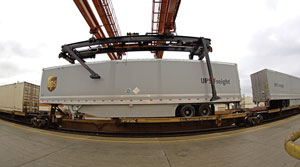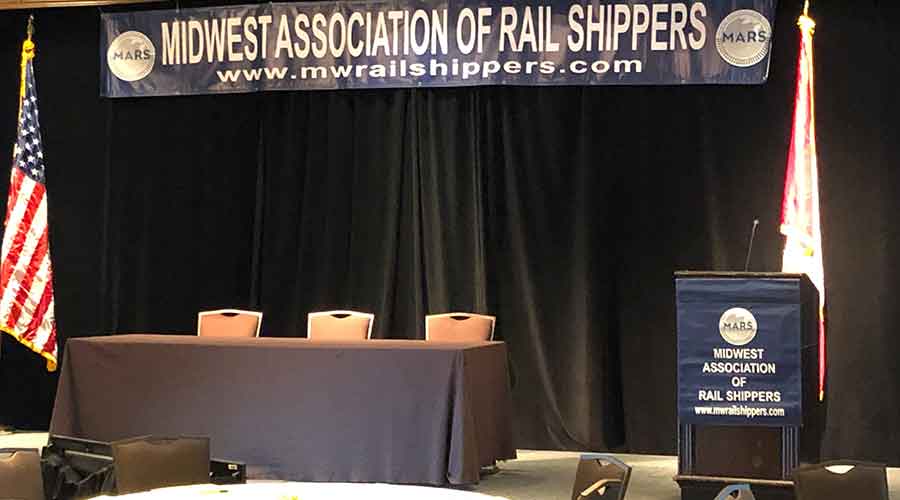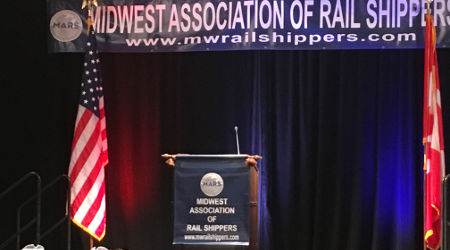Stay updated on news, articles and information for the rail industry
February 2014
Rail News: Shippers
United Parcel Service expects a rail-service rebound after a 'disappointing' 2013
By Jeff Stagl, Managing Editor
For United Parcel Service (UPS), on-time availability is the most important metric when it comes to measuring rail performance.
Instead of tracking a train's arrival time at a yard near a UPS sorting facility, the metric determines if the world’s largest parcel delivery company is provided loads as promised to sort packages on schedule at hubs within its integrated network. UPS taps service from all the Class Is and several other railroads in the United States, and each is assigned an availability goal of 95 percent.
“On-time availability is the be all, end all for us. Overall, it’s how we look at impacts on our whole network,” says Ken Buenker, UPS’ vice president of corporate transportation services, who’s responsible for rail transportation company-wide.
Unfortunately, the measure didn’t measure up last year, he says. Railroads’ on-time availability collectively declined a bit in 2013 after the metric posted improvement each year since 2009.
Last year, there were significant weather events that hampered rail service — as there are every year — a high failure frequency due to derailments, several engine failures and some maintenance-of-way work that “was hard to get around,” says Buenker. In addition, a few lanes registered high volume levels that placed all traffic under duress to meet required transit times, he says.
“Maybe [the railroads] got caught short-sighted. We are disappointed in the downward trend,” says Buenker. “But I think last year was an aberration, not a fundamental shift or an earthquake. It was enough to say something’s not right, and we got a line of sight on what needs to be done.”
As such, the downtick in rail performance likely won’t continue in 2014, he believes.
“Railroads know where the constraints are and are trying to get ahead of it,” says Buenker.
For example, a number of railroads have allocated dollars in their 2014 capital spending budgets to build sidings in capacity-constrained areas. Some roads have advanced the funding a couple of quarters in their long-term plans to complete the work, says Buenker.
In addition to incremental rail-service improvements, 2014 likely will mark more steps in UPS’ ongoing conversion from trailers to containers, he says. Over the past several years, the company has emphasized a transition to fewer trailers on all North American railroads because containers can be more efficiently double stacked.
“It’s like widening the throat,” says Buenker. “We did the simple ones to convert, the railhead to railhead, and now we’re doing the complex ones [that go] beyond the rail yard pieces.”
UPS also plans to modernize its North Bay sorting hub in the San Francisco Bay area this year — a project that will require a vital assist from railroads since a rail line feeds directly into the facility.
To begin in March and conclude in October, the project calls for adopting more automation technology at the facility and perhaps increasing containerization, says Buenker.
“There’s already a large amount of UPS traffic on the line,” he says. “The railroads are in tune with our plan and know our schedule. It’s a collaborative effort.”
Longer term, UPS is counting on more collaboration to factor rail into other books of business beyond parcels, such as freight forwarding, transloading and healthcare products distribution. Those businesses are an outgrowth of UPS’ ongoing efforts to analyze customers’ supply chains to find ways to make them make them more efficient, says Buenker.
As has been the case throughout the company’s more-than-a-century existence, personal interactions are key — relationships with customers need to be more intimate than just handling and delivering their packages, he says.
Once in a while, UPS needs to remind railroads and other business partners about that, says Buenker.
“In healthcare [products distribution], we say ‘it’s a patient, not a package.’ We look at every package that way, to keep it personal,” he says.
Keywords
Browse articles on United Parcel Service rail shipper intermodalContact Progressive Railroading editorial staff.


 2025 MOW Spending Report: Passenger-rail programs
2025 MOW Spending Report: Passenger-rail programs
 Gardner steps down as Amtrak CEO
Gardner steps down as Amtrak CEO
 Guest comment: Oliver Wyman’s David Hunt
Guest comment: Oliver Wyman’s David Hunt
 Women of Influence in Rail eBook
Women of Influence in Rail eBook
 railPrime
railPrime






